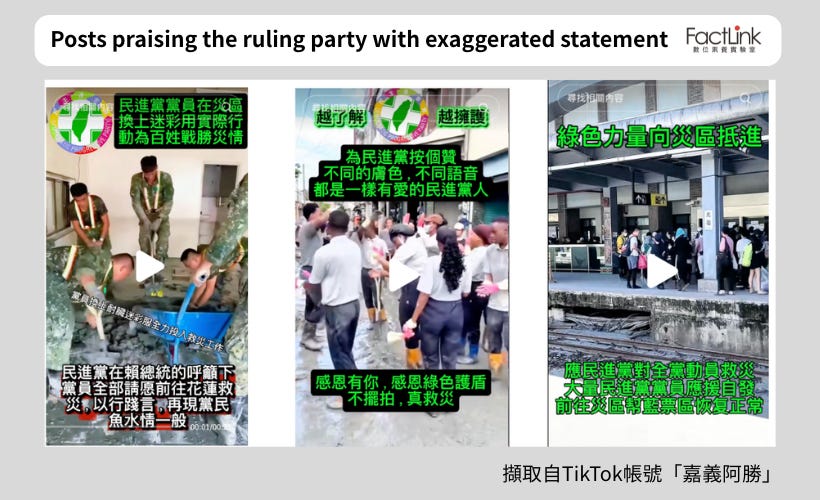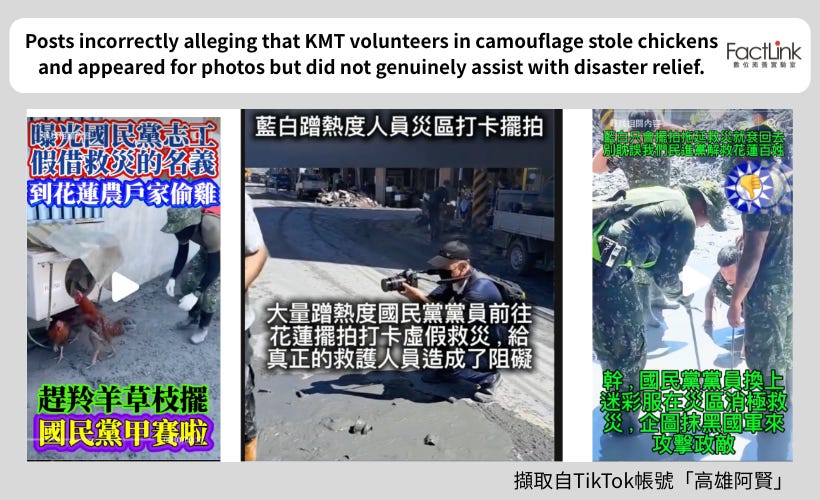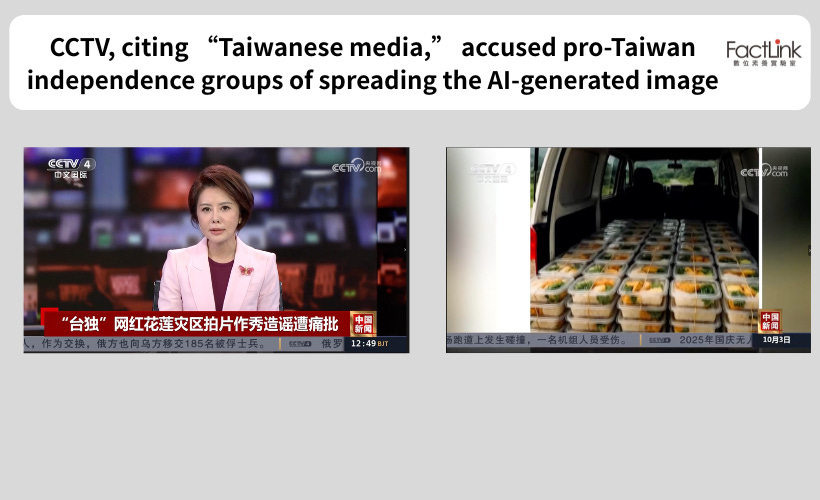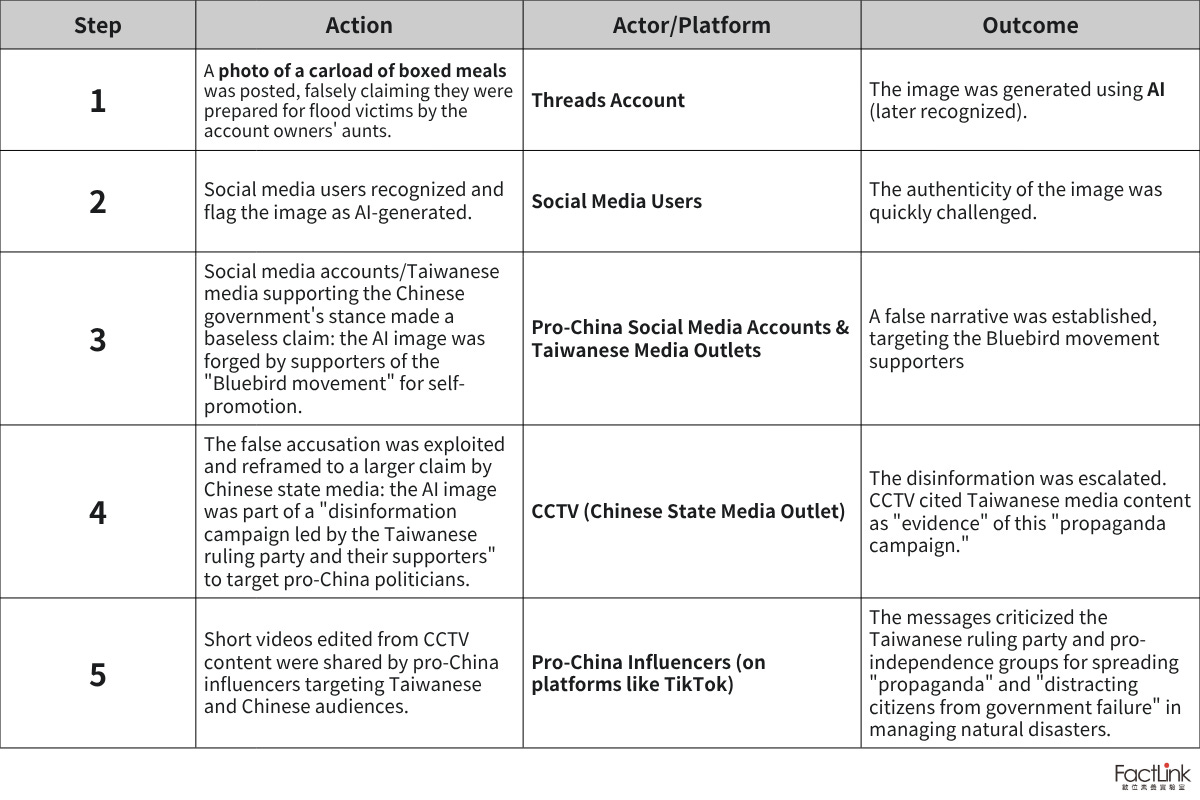'Are They One of Us?' :Butterfly Attacks and Conspiracy Theories Fueling Taiwan's Internal Divide and Distrust
Authors: Wei-Ping Li, Mary Ma, Summer Chen
English Report Download Here
中文版文章在這:【線上淤泥戰】花蓮光復救災的「反串嫁禍」資訊攻擊分析
Key Findings:
1.This report highlights two cases where malicious actors used information manipulation tactics such as “butterfly attacks” and leveraging conspiracy theory narratives to sow division and distrust in Taiwan. 2.During a crisis caused by Typhoon Ragasa in late September 2025, impostors pretending to be supporters of Taiwan’s ruling party spread unfounded messages, including false accusations that volunteers who helped clean up the typhoon damage were stealing money from victims. The false information triggered real-world disturbances against innocent business owners and online confrontations among social groups.3.In another instance, malicious actors took advantage of an AI-generated image, whose original source was hard to identify, to spread a "false flag"-like conspiracy theory, accusing Taiwanese local groups opposing China’s influence of staging events for their own gain. This theory was propagated via social media accounts and some Taiwanese media outlets sympathetic to the Chinese government. It was further magnified by Chinese state media, CCTV. The CCTV footage of negative propaganda against Taiwan’s political factions was then recycled to become short videos and circulated back to Taiwanese social media platforms, eroding public confidence in Taiwanese politics, citizens, and the information environment. 4.In recent information manipulation campaigns, we have seen how the public’s awareness of false information can be exploited: While citizens’ vigilance against false information is helpful, it can also lead to increased distrust and fuel negative emotions and dissatisfaction with politics, social groups, and the media. Recognizing false information is valuable, but rebuilding trust is just as important.When conducting information interference campaigns, one of the malicious actors’ primary aims is to create divisions during crises or elections in democratic countries. For example, Russian propagandists have historically impersonated US citizens on social media to spread divisive messages and create conflicts in American society during elections. Recently, FactLink also observed an increase in information campaigns using propaganda tactics, such as “butterfly attacks” and the leverage of conspiracy theories, to manipulate political and identity debates in Taiwan during crises, with the goal of fueling discord. The fake content has been disseminated via social media platforms, amplified by some Taiwanese media, and cited by Chinese state media as real events to discredit Taiwanese groups opposing Chinese interference. In one case, some accounts spreading the disinformation are associated with a Chinese company known for managing content farms that previously interfered in the 2024 Taiwanese presidential election by promoting messages supporting a particular presidential candidate.
One of the most recent instances of information manipulation exploiting key challenges in Taiwanese society occurred during a disaster caused by the super typhoon Ragasa. In late September 2025, Typhoon Ragasa brought torrential rain to eastern Taiwan, causing mountain slope collapses and the overflow of Matai-’an Creek barrier lake. Tons of sludge rapidly descended, flooding Guangfu, a town in Hualien, resulting in multiple deaths and severe damage to the community. Watching the disaster unfold on the media—an event residents hadn’t seen in decades—crowds of volunteers from across Taiwan gathered with shovels and tools, rushing to Guangfu to help clean up. The story of these volunteers demonstrating kindness and solidarity highlights the unity and camaraderie among the Taiwanese. However, malicious actors also exploited these heartfelt moments, attempting to ruin the sense of fellowship by impersonating volunteers to spread false allegations against other groups and implanting conspiracy theories.
Butterfly Attack: the Impersonation of “pro-Taiwan” TikTok Accounts
FactLink observed and traced the flow of posts discussing the overflow of Matai’an Creek and damage in Guangfu on popular social media platforms among Taiwanese, including Threads, TikTok, Instagram, and Facebook, from September 23 to October 10.1
During this period of time, many social media users shared images and videos praising volunteers, including migrant workers from Southeast Asia. However, several TikTok accounts displayed highly abnormal content: while claiming to praise the volunteers’ camaraderie and “their love for Taiwan,” the messages largely contained exaggerated praise favoring the ruling party, the Democratic Progressive Party (DPP), with bitter attacks against the opposition party, the Kuomintang (KMT) and migrant workers from Southeast Asian countries. Three TikTok accounts notably shared similar profiles and themes, posting 80 videos over 17 days from September 23 to October 10, all focused on false information about flood volunteers.
A closer look at these three accounts and the disturbing videos found that they propagated senseless information. For example, TikTok videos praising “ruling party DPP’s volunteers” used irrelevant images to depict a non-existent event where “the DPP members dressed in military uniform to help clean the sludge.” Some posts falsely accused Vietnamese volunteers or opposition Kuomintang members of stealing money from flood victims. A post incorrectly claimed that “members of the Communist Party came to help, but male Communist members only stand aside to watch female members work.” In fact, it is rare in Taiwanese society for anyone to openly self-identify as “members of the Community Party.” In a video contrasting “Chinese strawberry soldiers” (where “strawberry” means weak in the Chinese-language context) with “strong Taiwanese soldiers sent by God,” the post mixed up images of Taiwanese and Chinese soldiers. These contradictory and false messages are glaring signs of inauthentic information.
The FactLink team further examined the accounts to verify their authenticity. Interestingly, several TikTok profiles claimed to own local tea stalls in a Kaohsiung night market or branches of “Loushifan” (a popular Chinese noodle soup) restaurants in other Taiwanese cities. However, none of the social media posts by the accounts referenced the businesses they claimed to operate. Instead, their posts mostly focused on Taiwanese politics, incidents in China, and cross-strait relations, often containing false information or distorted perspectives on current events. An interview by FactLink with the tea stall owner in Kaohsiung referenced by one of the TikTok account revealed that the social media account’s claim of being connected to the stall is false (the stall owner stated they were unrelated to the social media account); additionally, the Loushifan restaurants had already closed before the posts were created.
In fact, these social media accounts pretended to be real individuals with businesses in Taiwanese communities and disseminated false information about Taiwanese politics and society.
Although these posts are suspicious, they have led to real-world disturbances. Some viewers left comments expressing hurt over being falsely accused of theft, while others found the videos dubious and were upset about the spread of unverified information. Eventually, those doubting the video’s authenticity and those asserting that the videos were genuine engaged in online verbal confrontations. Moreover, some viewers, angry at the fake videos but not investigating the accounts’ true identities and motives further, doxed the location of the tea stall mentioned by one account and left negative reviews on its Google Review page, resulting in the owner and the business suffering from harm due to the impersonation of the TikTok account.
The leverage of conspiracy theory and the amplification by the Chinese state media
The example of the above TikTok videos showed how disinformation with an impersonation tactic can cause social division during moments of solidarity. This tactic is a form of disinformation technique known as a “butterfly attack,” in which malicious actors impersonate in-group members by mimicking their behaviors, then spread or provoke controversial statements that cause conflicts.2
The next example also involved impersonation within the information manipulation chain. However, malicious actors additionally employed a “false flag”-like conspiracy theory to discredit certain Taiwanese civilian groups and supporters of political parties. They alleged that the DPP, its supporters, and social groups staged an event to boost their image or divert criticism.
The ‘false flag conspiracy theory‘3 generally involves claims that a government or powerful group stages a fake event to distract attention from a more significant issue. For example, after mass shootings in the United States, some social media posts alleged that the incidents never happened, asserting that the media or government fabricated the reports to cover up their other misconduct. During Russia’s invasion of Ukraine, some claims alleged Ukrainians staged photos or incidents to promote propaganda against Russia. However, these claims were debunked as a conspiracy theory propagated by Russian media or influence campaign actors.
In this present case, the information manipulation incident started from an AI-generated image that was also seemingly meant to celebrate Taiwanese camaraderie after the typhoon disaster. Days after volunteers flocked to help Guangfu, an inauthentic Thread account posted a photo showing a carload of boxed meals, claiming they were prepared by the account owners’ aunts for flood victims. The photo was then widely shared across various Facebook groups and fan pages, including one called “pray for you” (為你祈福), and garnered thousands of comments and 36,000 “likes.” However, the “pray for you” fan page was operated by the company named “WUBIANJIE” [無邊界公司] based in Qinhuangdao [秦皇島], Hebei, China, which researchers had identified as owning multiple online content farms and managing accounts purportedly based in Hong Kong to influence the 2024 Taiwan presidential election.4
It didn’t take long for social media users to recognize this image as AI-generated. However, in the absence of evidence, some social media accounts and Taiwanese media outlets that frequently echoed the Chinese government’s statements quickly alleged that the AI image was forged by supporters of the “Bluebird movement” to attract attention and promote their agenda. The “Bluebird movement” was a 2024 social movement protesting controversial legislative bills that dramatically reduced government spending, including the essential national defense budget. In 2025, many supporters of this movement launched a campaign to recall KMT legislators they considered unfit due to the KMT legislators’ strong alignment with the Chinese government’s interests.
The unverified accusation that supporters of the Bluebird movement created a fake image for self-promotion was further exploited by CCTV, a Chinese state media outlet. CCTV reframed the claim, falsely asserting that the AI-generated image of boxed meals was part of a disinformation campaign led by the Taiwanese ruling party and supporters of Taiwan’s independence to target pro-China politicians. Additionally, CCTV cited Taiwanese media content as “evidence” of the Taiwanese ruling party’s “propaganda campaign.” Soon after, CCTV’s content was edited into short videos and shared by pro-China influencers with both Taiwanese and Chinese audiences on social media platforms like TikTok, criticizing the Taiwanese ruling party and pro-independence groups for spreading “propaganda” to promote their agenda and distract citizens from the government’s failure to manage natural disasters. (See Table “The information manipulation chain from social media to the Chinese state media” at the end of this report).
The spread and manipulation of AI-generated meal box images highlight how disinformation tactics, similar to the ‘false flag conspiracy theory,’ are ingrained in the Taiwanese media landscape and exploited by malicious actors. Along the path of the information spread chain, other malicious parties, such as Chinese state media, stepped in to exploit the incident, prolonging the life of the conspiracy theory and expanding the information’s influence.
In this case of the AI meal box image in Taiwan, although it’s challenging to definitively prove coordination among pro-China social media accounts, Taiwanese media outlets, and Chinese state media in creating and amplifying the "false flag"-like conspiracy theory, it’s evident that malicious actors and Chinese state media have become increasingly adept at timing their rumors and repackaging them to erode Taiwanese citizens’ trust in each other and their political institutions.
Furthermore, this tactic also exploits Taiwanese awareness of information campaigns. Over the years, efforts by various social groups, media outlets, and the Taiwanese government have led Taiwanese people to become more aware of the problem of false information and to strongly detest manipulation, whether by the Chinese government or local actors. Ironically, manipulators also exploit Taiwanese’s suspicion and disdain of deception to intensify their schemes. This may further diminish Taiwanese public trust in the credibility of the information and create more opportunities for information manipulation. At a time when accurate information is vital for Taiwanese to defend democracy and resist China’s interference or military threats, restoring trust in credible sources is urgent and essential.
*We would like to thank Jerry Yu, Senior Analyst at Doublethink Lab, for providing his consultation for this report.
The FactLink team traced the posts from the date when the flood occurred on September 23 and stopped collecting data on October 10 when the issue faded from social media discussions and the social media accounts shifted their focus.
See T0094.002 “Utilize Butterfly Attacks” - Disarm Framework Explorer. https://disarmframework.herokuapp.com/technique/134/view
See Uscinski, J. (2021, December 7). Five things to know about ‘false flag’ conspiracy theories. The Washington Post. https://www.washingtonpost.com/news/monkey-cage/wp/2018/10/27/false-flag-theories-about-the-mail-bombs-are-already-widespread-here-are-5-things-to-know-about-conspiracy-theorists/
See 王宏恩. (2024, June 4). 王宏恩專欄—河北秦皇島公司控制香港帳號介入2024台灣總統大選 – 思想坦克|Voicettank. 思想坦克|Voicettank. https://voicettank.org/20240604-1/









